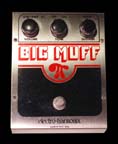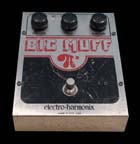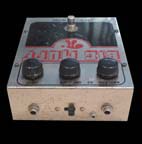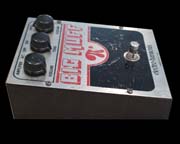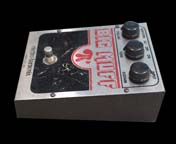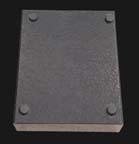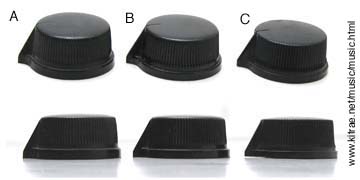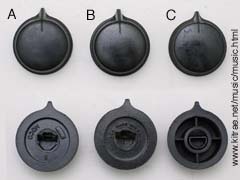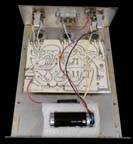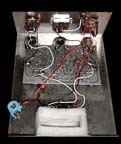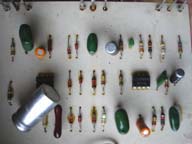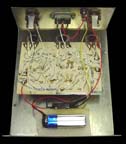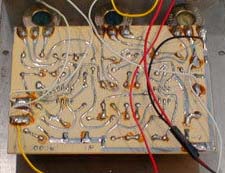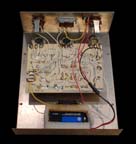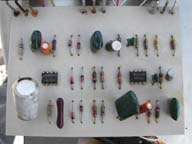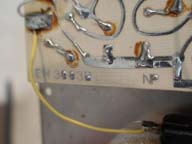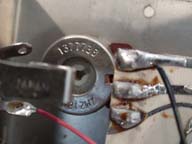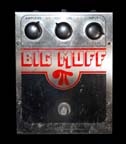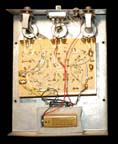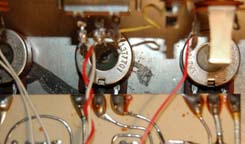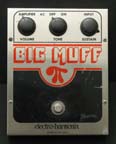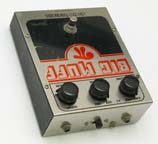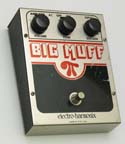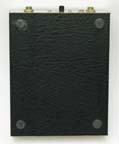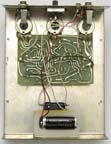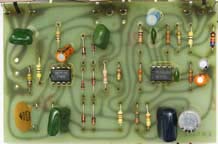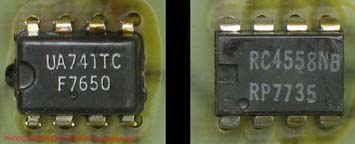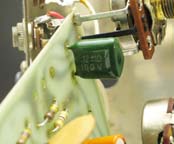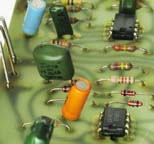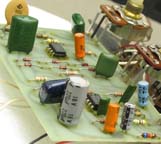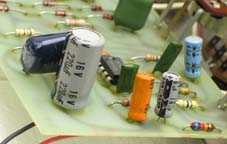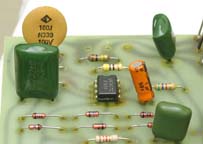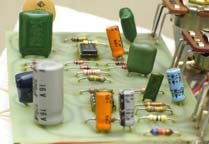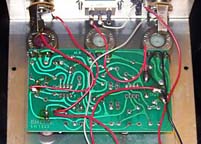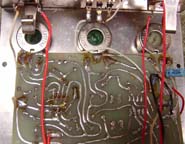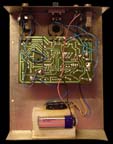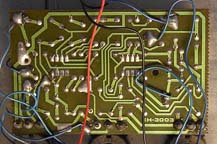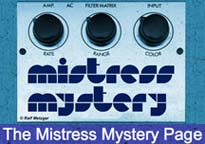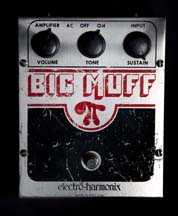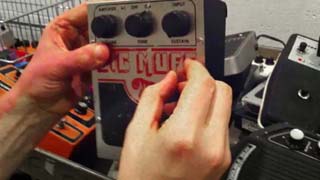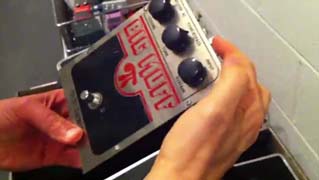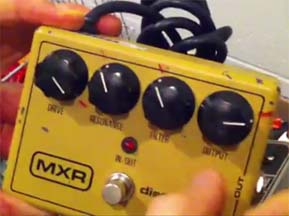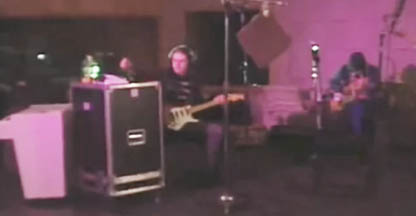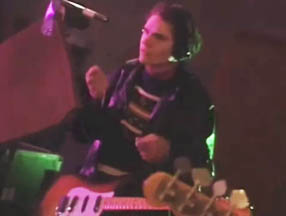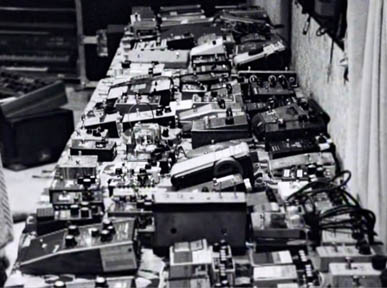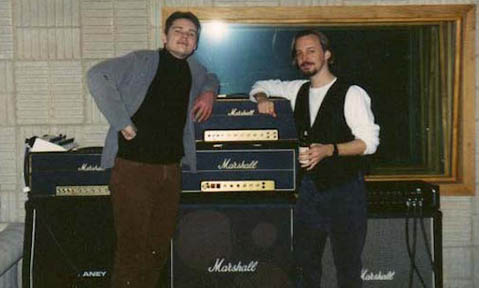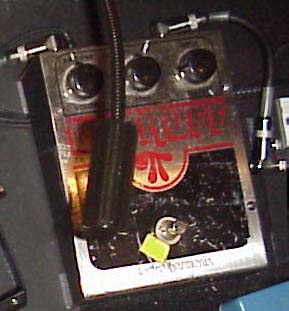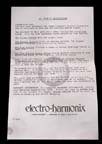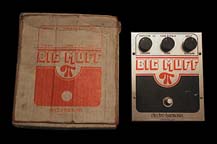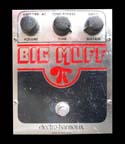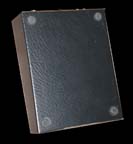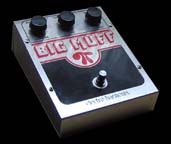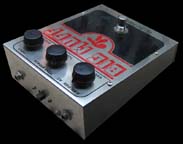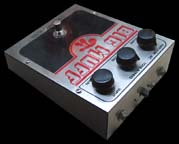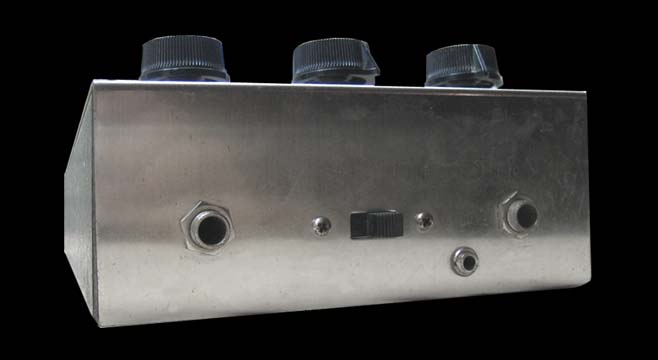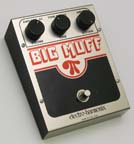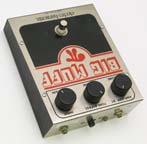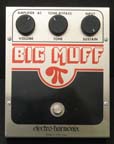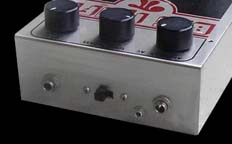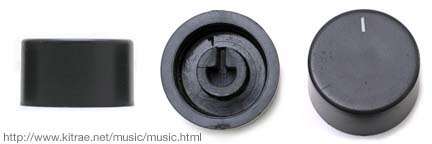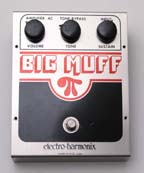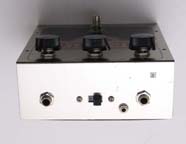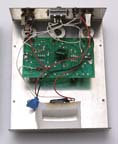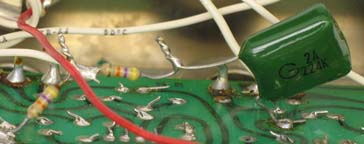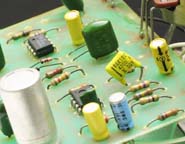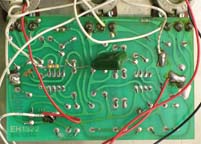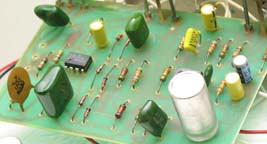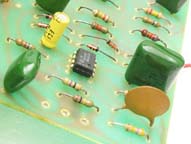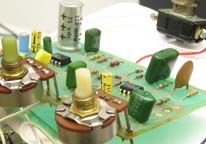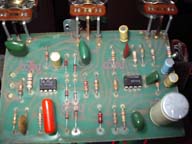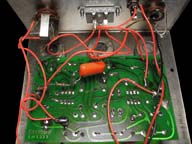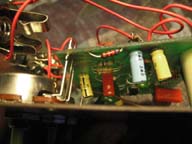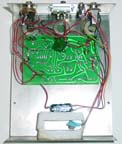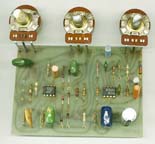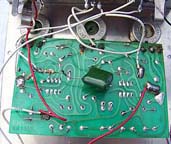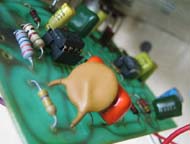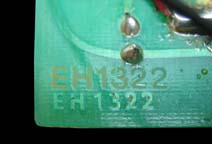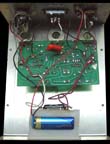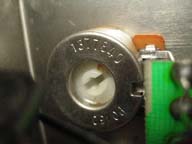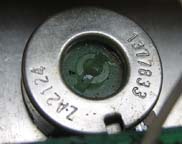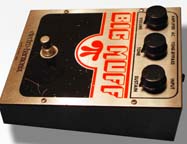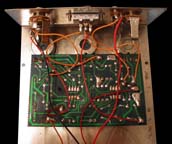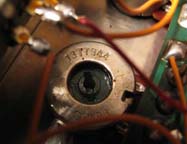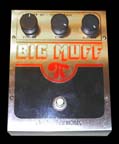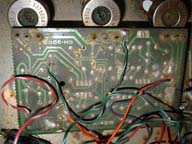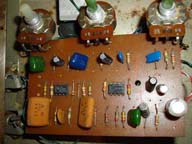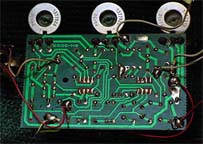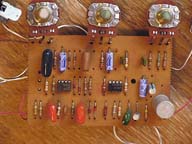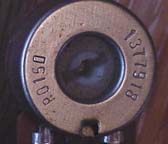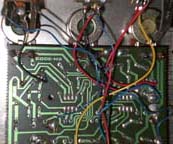THE BIG MUFF π - A HISTORY OF ALL VERSIONS - Part 1
Click on any Big Muff in the image below to go directly to that section
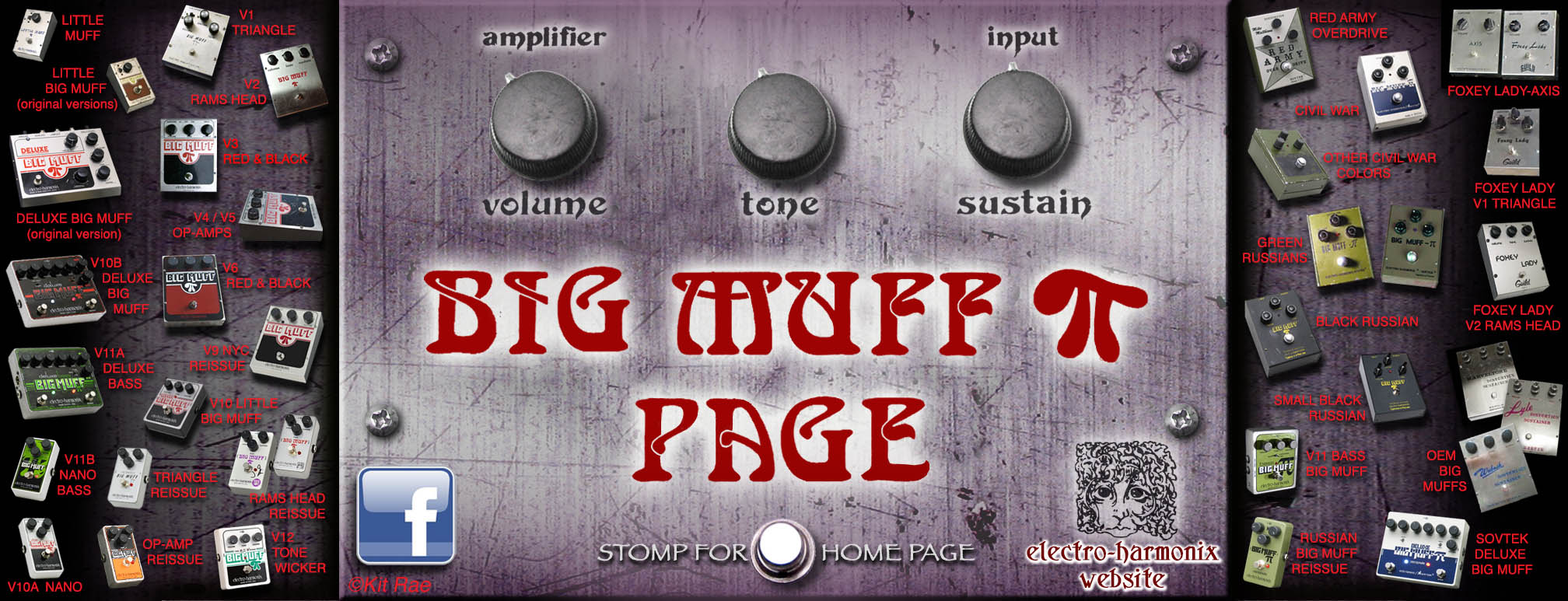
NOTE: Last update February 2024. This website is constantly updated as new information becomes available. Version, Edition, and Revision numbers listed here are not actual Electro-Harmonix identifiers. They are my categorizations, for identification purposes only. Permission required to repost any information from this site in any ebay listing. Website and contents ©Kit Rae.
THE OP-AMP BIG MUFF π - VERSION 4
Circa 1978 (Pots typically date as early as 1976 and as late as 1978)
Model Numbers: EH3003A, EH3003B, EH1322, EH1322B, EH3003
Circuit Designer: Howard Davis and Michael Abrams
Edition Versions: 1
True Bypass: No
Power: 9V battery or power jack for an AC adaptor. Jack is 1/8" (3.5mm) plug tip positive. This is reverse polarity of typical pedals so use an E-H power supply or use a converter adaptor like the 1 Spot C35 3.5mm Converter
Enclosure Size: 6 7/8 " x 5 1/2" x 2 1/4"(short end) x 2"(long end) / 174mm x 138mm x 35mm(short end) x 57mm(long end)
Packaging: White corrugated cardboard box with red printing
Place of Manufacture: Manhattan, New York, USA
Replacement Parts
Around 1978 Mike Matthew's Electro-Harmonix company was doing very well worldwide, with offices in Tokyo, London, and Toronto, in addition to the New York office. The 50,000 square foot Manhattan factory was generating five million in annual sales. The traditional four transistor Big Muff circuit was radically changed at this time to a new circuit that used op-amp chips and one less gain stage, in an effort to reduce manufacturing costs. Op-amps are operational amplifiers, also known as ICs (integrated circuits or chips). It is likely this version and the V5 tone bypass version listed below were made simultaneously, with the V4 version being phased out in 1978 or 1979. To economize production, two of the three circuit boards used in the V4 Big Muff were also used in the Little Big Muff pedal enclosure. They both used the same circuits, only the LBM was made with fixed resistors where the tone and sustain pots would be.
I am including this as a legitimate Big Muff, even though it does not use the classic Big Muff four-stage transistor circuit. It was intended to sound like a Big Muff and was released in the same box as Version 3, so I feel it must be included. Plus, I, and many others like them. Though not quite the same as the organic transistor tone, it had a very unique tone. Supposedly only a few thousand of this version were made.
GRAPHICS - The box, knobs, and graphics were identical to the second edition Version 3 BIG MUFF, and these V4 Muffs are often confused with the V3. The only way to tell is to look at the circuit board for the two distinct op-amp chips, or to turn the control knobs to see which way the pots are mounted, as illustrated below. V3s all have the pre 1978 configuration, and V4s have the post 1978 configuration.
CONTROLS / KNOBS - Standard Volume, Tone and Sustian controls, with a power switch on the jack side. Version 4 had the same plastic Daka-Ware control knobs and on/off switch as version 3, but there were also identical knobs used marked HDCO on the underside, and some unmarked knobs used. One major change to note was the was the positioning of the potentiometers on the circuit board. They were changed so that each wrapped around the top edge of the circuit board, allowing each knob to start at zero in the same position (finally!). All Big Muffs prior to the V4 had each pot mounted in a different position from the others. This also changed the TONE knob orientation so that bass was on the left and treble was on the right, as it has remained on all subsequent Big Muffs.
CIRCUIT - The V4/V5 circuit was about half the size of the V2/V3 transistor circuit, but there were at least five different pcb layouts used. Early versions of the op-amp circuit board were similar size to the V3 circuit and were marked with "EH-3003A" or B. Then a smaller size pcb was made, marked "EH-1322" and "EH-1322B." Later production changed back to the simple "EH-3003," the same number used on the V2/V3 versions. Three of the four circuit boards, the EH1322, 1322B, and 3003, included extra pads for another volume pot position. The extra pot pads were to allow the circuit board to fit sideways inside the Little Big Muff pedal enclosure, which used the same circuit but only had one control knob for volume.
The V4 used two op-amp chips, one RC4558NB and one of several versions of the 741 chip, such as the UA741CP, UC741TC, LM741CN, and LM741CM. A modern equivalent of the old RC4558NB would be the JRC4558D. The volume pot was usually linear taper 100k, although I have seen one with a 50k pot. Tone and sustain pots were 10k. The tone cotrol design was similar to the transistor version, but uses very different values and had more cross over of the high and low frequencies.
Howard Davis, Manager of Analog Circuit Design for E-H from 1976-1981, claims credit as the circuit designer for this version, as does former EHX designer Michael Abrams. Howard was responsible for over a dozen E-H pedal circuit designs, as well as most the the ”deluxe“ Electro-Harmonix models that appeared in the late 1970s to early 1980s, including the superb op-amp Deluxe Big Muff, Deluxe Memory Man, and Deluxe Electric Mistress. The op-amp Big Muff was assigned to Howard to fill a desire for a simpler, less costly product that would do all that the transistor version did. However, due to the differing distortion characteristics of the op-amps it turned out to have a somewhat "grungier" sound than the transistor design, an effect preferred by some musicians. The circuit was made with one of the popular 741 op-amps and one RC4558 dual op-amp, though occasionally V4 Big Muffs are seen with different chips. Howard's original design schematic, dated 4/6/1978, included the tone bypass switch, seen on the V5 Big Muff. He does not recall ever designing a non bypass version, but sometimes changes were made to his designs by others at E-H that he was not made aware of, which may explain why the V4 version did not include the tone bypass function. The feature was included on the Version 5, which was likely made at the same time as this version, based on the fact that they both share three of the four diferent circuit boards used, and similar pot dates.
When I asked Howard about how the op-amp version originated and how he got involved in the redesign, he had this to say -
"As chief engineer for Electro-Harmonix, basically my direction ( from E-H owner Mike Matthews) was to design a Big Muff using op-amps. He often would just tell me to "think about" something, and I took it from there. The transistor version is somewhat sweeter sounding (than the IC version). Grunge and punk-style players though often want something with more edge or coarseness, more crunch, and the IC Big Muff is just what they want. It can give you the Mountain sound - the guitar rough around the edges, but with the rest of the band playing, melodic overall."
Howard was still involved with his E-H creations at the time this articel was written, doing custom mods and repairs to vintage Big Muffs, as well as his other E-H pedals. Here is an interview with Howard about his work on the Big Muff circuit from 2009.
There was NO LED light on this version. Power was from a 9V battery or an AC power adaptor jack. The top had to be removed to change the battery. These had four rubber feet and shipped in a corrugated cardboard box. Most of the pots are dated 1977, though these were all likely made in 1978.
CLONES OR SIMILAR PEDALS - E-H released a reissie Op Amp Big Muff in the nano sized enclosure in 2017. The Deluxe Big Muffs from the late 1970s also used a nearly identical circuit to the V4, as well as some of the Little Big Muff pedals Electro-Harmonic made in the same time period. Later replicas are the Euthymia ICBM, Stomp Under Foot Op-Amp Fuzz. See DiscoFreq's Effects Database for a thorough listing of all the Big Muff clones and variants throughout the years.
THE V4 SOUND - This is a great distortion pedal with much of the same scooped mids character of the previous transistor versions. Very close, but not exactly the same sound. Overall the V4 has less gain and less bottom end than most of the V3 and V6 transistor versions, but the V4 is also much quieter than a V3 or V6 when the sustain is maxed. It sounds like it has a slightly flatter mid range than the V3 or V6, but the mid range notch actually dips a bit more into the lower mids than those. I think the transistor versions are more organic and reactive to pick attack, palm muting, and harmonics than the V4, but the V4 still sounds great for crushing, grungy, wall-of-sound distortion, heavy rhythm playing, and heavy leads. Dropped D tuning with humbucking pickups is where this version excels. The V4 fizz or buzz that is typical with a Big Muff has a slightly more machine-like, metallic feel in this one than the transistor versions. Compared to the hint of a revved motorcycle engine underlying the fuzz of the transistor versions, the V4 has more of the hint of a ripping chainsaw underlying the fuzz. As with the transistor versions, the scooped tone makes them easy to get lost in a band mix when playing live with certain amps.
Unlike the transistor versions, the V4 tone is very consistent from unit to unit. Some units may have a noticable volume/gain boost when the pedal is switched off due to the fact that these old Big Muffs do not bypass the signal even when off. The signal still goes through and is amplified by the active op-amps, which can sometimes add a gain boost. Adding a true bypass switch can eliminate this problem. This is likely the primary Big Muff circuit heard on most of Smashing Pumpkins' Siamese Dream and Pisces Iscariot albums, so that should give an idea of the potential of this version. This is the rarest of the two op-amp Big Muff versions.
CLICK A PHOTO TO ENLARGE
Shown above - V4 op-amp Big Muffs with pots dated 1977. The V4 features an on/off switch and the words ON and Off appear on the graphics, which are identical to the V3 Big Muff. The only way to tell the difference is to examine the circuit board, which will have two op-amp chips rather than four transistors.
Shown above (left to right) - V4 op-amp Big Muff packaging, which was identical to the V3 Big Muff. There were various D-shaft knobs Electro-Harmonix used on the V4 Big Muffs, pictured above. (A) HDCO, (B) Daka-Ware made by Davies Molding of Chicago, (C) unmarked V4/V5 knob
Shown above (left to right) - Big Muffs with the first op-amp circuit board, manrked 3003B, all with pots dated 1976 or '77.
Shown above (left to right) - Another V4 Big Muff with 3003B circuit board and 1977 pot dates. Note the positioning of the potentiometers so that each wraps around the top edge of the circuit board allowing the knobs to start at zero in the same position. All Big Muffs previous to the V4 had each pot mounted in a different position from the others.
Shown above (left to right) - V4 op-amp Big Muff with the second circuit board, marked EH-1322, and 1976 pots. Note the two black op-amp chips on the circuit board, each with eight connection leads. The V5 tone bypass version was made with this exact same circuit board at the same time. Note the three extra volume pot pads you can see on the populated side of the board. This was to accommodate the Little Big Muff, which shared the same pcb. The LBM only included a volume pot, and was mounted sideways in the enclosure, requiring the volume pot to be mounted differently.
Shown above (left to right) - Two V4 op-amp Big Muffs with EH-1322 circuits, and 1977 pots. The V5 tone bypass version was made with this exact same circuit board at the same time.
Shown above (left to right) - V4 op-amp Big Muff with the fourth curcuit board, marked EH-3003, 1978 pots, and hockey puck knobs. The V5 tone bypass version was made with this exact same circuit board at the same time. Note the extra volume pot pads, which allowed this board to be used in the Little Big Muff enclosure. The LBM only included the volume pot, and was mounted sideways in the enclosure.
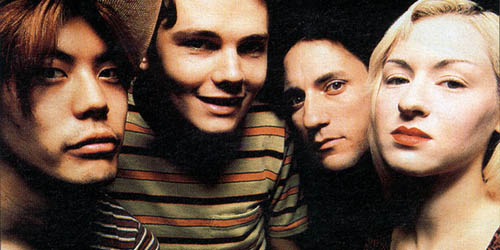
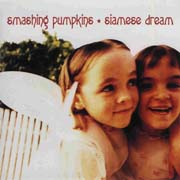
BILLY CORGAN AND THE SIAMESE DREAM TONE - A very popular V4 Big Muff user was Billy Corgan, who used it briefly on the Gish album, to very good effect on the Smashing Pumpkins' Siamese Dream album, and several tracks that later appeared on Pisces Iscariot, all recorded in 1991-93. Siamese Dream was one the the landmark albums of the 1990s, and is still highly praised today. It was not only a standout album in the arena of Big Muff tones, but the BMP was integral to the whole feel, mood, and sonic depth of the recordings. Here is a quote from Billy about the importance of the Big Muff to the Siamese Dream sound.
"To me the Big Muff pedal changed the entire course of the album (Siamese Dream). That album is a classic album because of a certain way of thinking with this pedal. So when people say “why was this a classic album” and they wanna talk about pain and drugs and Jimmy (drummer Jimmy Chamberlain), the Big Muff is just as important" - Billy Corgan from a 2005 Netphoria interview
"To me, the Electro-Harmonix Big Muff produces the ultimate super-gain VROOOM sound." - Billy Corgan from his June 2011 Guitar World article
Shown above - Billy Corgan V4 Big Muff used for the Siamese Dream recordings, showing his exact settings used for most of the recordings
There was much speculation over the years about which Big Muff was used for SD. Many of us Big Muff users thought he must have used an old Triangle Big Muff. Creative urban Muff legend had it that Billy used a black Sovtek Russian Big Muff with a "creamy dreamer" mod, athough the black Sovtek BMP did not exist at the time, and the Creamy Dreamer pedal did not even exist until around 1999, all years after Siamese Dream was recorded.
Based on listening to the isolated guitar tracks, and my experiments achieving this tone using some of the same gear Billy described, I believed this to be a late 1970s op-amp Big Muff. Billy Corgan revealed in late 2009 (on producer Kerry Brown's Ain't No Sleep When You're Living the Dream blog) that he indeed used a vintage USA Big Muff through a Marshall JCM 800 100 watt head. His photo of the actual Big Muff used showing his exact settings confirmed my suspicion that it was an op-amp (IC) version. Specifically, a V4 Big Muff. The graphics match second edition V3 and V4 Big Muffs, but the tone and sustain pot sweep as Billy set them were only possible on a stock V4. I posted this revelation on a guitar fprum at the time, not thinking anyone would care because the op-amp Big Muffs were looked down upon as inferior to the transistor versions. They were cheap and easy to find if you wanted one. Unfortunately, once word spread that this was the Siamese Dream sound, the resale prices skyrocketed and V4 and V5 Big Muffs soon became expensive and rare collectibles!
Billy and James Iha used two Big Muffs for the Siamese Dream sessions, pictured below. The Marshall amp they were played through was modded to fit KT88 China tubes for more clean head room and less amp distortion, rather than the stock EL-34 tubes.
Shown above - Billy Corgan showing his Siamese Dream era V4 Big Muff and a V5 (or possibly tone bypass V3). On the right is an MXR Distortion II that, according to Billy, was fed into the Big Muff for solos. These are the actual settings used (screen shots from the Oceania recording sessions in 2011)
Billy has stated that he got the idea of using a Big Muff after hearing rehearsals of fellow Chicago band, Catherine. All three guitarists in Catherine were using Big Muffs simultaneously. Both bands used the same rehearsal space, and members of both bands have played on each other's recording at various times in the studio. Billy Corgan even produced Catherine's first EP in 1993. Corgan may have gotten the idea for the Big Muff sound from hearing Catherine, but many of Catherine's songs sound eerily the same as the SP Siamese Dream sounds, with identical guitar tones and playing styles. In fact, Catherine was later called a Smashing Pumpkin's clone. Both bands seem to have been heavily influenced by each other, borrowing sounds, despite the fact that Billy has stated that each band trusted the other not to steal their sounds. Here is how Billy described first hearing the Big Muff from his blog.
"As I am good friends with our space mates (the local band) Catherine, I often stick around for their rehearsals to check out what they are working on and offer unsolicited advice…I notice that in this tight room, they sound very like some kind of jet taking off when they play…the feeling is very exciting, and being the sound whore that I am, I not so slyly interrogate them about how they create this dizzying effect…they all point sheepishly to these little silver boxes on the ground, and tell me that’s about it...
Their vintage pedal, invented by The Electro Harmonix Company, is a simple old school distortion/fuzz device called ‘The Big Muff Pi’…manufactured back in the 60’s and 70’s, it comes in a brushed metal frame, with cheap black knobs (the later models are more easily recognized by the big red Pi symbol stamped on the faceplate)…they sell used for about $75-100, and there are only three critical settings: volume, tone, and sustain (the volume sends the amount of signal to the amp, the tone the amount of bass vs. treble, and the sustain basically means how much fuzz overload you are going to get)…I notice that when the boys play the space hums with an electrical energy that shoots thru my bones and rattles my teeth…it’s as if this room is made for this sound…they tell me that the reason they like using the pedal is the deep booming sludge it makes, as the sound within collapses from the intensified pressure, creating a bigger presence when they rock hard (and also managing to hide a few inconsistencies in their playing)…the affect is immediate, as they suddenly appear to me to be a much more dangerous combo than I last remember…somehow the alchemy of the concrete walls, the cool air, and this dumb little pedal make the band sound like God himself is coming down from the heavens…which of course means I have to go get one for myself…"
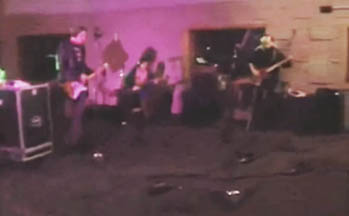
Shown above - The Smashing Pumpkins sessions at the Triclops recording studios in Atlanta, Georgia 1993
According to Billy, the Pumpkins first use of the Big Muff on record was the first solo in the song Siva from the Gish album in 1991. The tone was achieved by dialing the guitar tone knob to the bass side, eliminating the treble, sort of like the Clapton 'Woman Tone' effect.
The band only had one Big Muff in the beginning that guitarists Jamies Iha and Billy shared. They also used a vintage green Electro-Harmonix Electric Mistress. At the time of Siamese Dream recordings, they owned 2 different Big Muffs, the V4 version, and what appears to be a tone bypass V5 version, or possibly a tone bypass V3. There were numerous other fuzz pedals used and not much song-by-song documentation, but Billy and Butch have revealed details in various articles and interviews over the years. Here is what Billy had to say about the power and difficulty of using two Big Muffs in the band from his blog.
"It is almost impossible to describe the intensity of the practice space when the Pumpkins are playing at full tilt with The Big Muffs cranked…the basic dimensions of the room are around 25ft x 15ft, with the basic band circle smack in the middle of the shoebox…when you have possibly the loudest drummer in the world playing with passion and power (not to mention about 10 crash cymbals slicing the air) vs. 2 100watt Marshall half-stacks and one 400watt SVT bass amp, you’ve got your basic dull roar fully in hand…add this to that the fact that we are playing in a stone bunker with little or no soundproofing and you’ve got yourself a decent headache blast…but what really puts these tunes over the top, what makes the whole thing ring, and what discreetly pours our liquid brew from sonic anecdote into our own rock and roll riot, is switching to this almost forgotten device…"
"We are obsessed with technical precision, for it is obvious to us that the tighter we play the heavier we sound…adding the Big Muff pedal into our charge makes us appear wider and meaner than we truly are, but all this beefed up bludgeoning comes at a hidden cost…because the sound is so grossly overblown (the amps sound like they are going to explode at any second), the band sadly doesn’t sound tight at all…at first, we figure the sound of the fuzz is going to take some time for us to get used to, and because we are having so much fun playing along with them anyway that it doesn’t seem like a big deal…but after only a few days, it becomes obvious that certain aspects of what we do, little things that we take for granted (namely our focused attack), disappear in a haze once we light ‘em up…we discuss ditching the pedals for good, naively talking ourselves into thinking that we can just go back to our normal sound and compensate in some other way...we only last a couple of minutes using our old equipment before we fall to a halt, puzzled because we now sound to our confused ears boring!…we are at a crossroads, as we have made a deal with the devil (of demon fuzz) and can’t seem to go back…it is a Faustian deal for this most exciting sound that makes us deliver invincibility, but by taking away our detailed intensity, also degenerates us to a common pub band…after some discussion, we unanimously decide the (Big Muff) fuzz pedals will have stay, and we will just discover a way, as yet unseen, to make them work…we will just have to practice all the harder…"
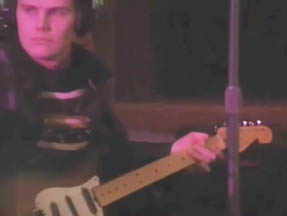
Shown above - Billy Corgan at the Triclops recording studios in Atlanta, Georgia 1993
To help prepare for the Siamese Dream recording sessions with Butch Vig, the band booked four shows at a local Atlanta club to get themselves in shape to play the new material. Many of the songs were basically just instrumentals at this stage, with lyrics yet to be written. Using the Big Muffs in a live situation proved to be a mistake. Big Muffs have tradedemark mid range scoop which can make it difficult to hear yourself play in a band mix on stage with bass guitar and bass drums that occupy the same frequencies. This is not a problem when you are just playing a guitar solo here and there with one, like David Gilmour of Pink Floyd for example. It is a major problem when both guitarist in a band are using them simultaneously to play a wall of power chords that make up the majority of every song.
"Because we have been cooped up for so long, the shows go fairly well energetically but are a bit of a train wreck musically…without forethought, we have transferred our normal practice set-ups to the stage, which means we are using the Big Muff fuzz pedals live…this proves to be a fatal mistake, because without the density of a small room around us, our guitars sound very thin and undefined rendering us sloppy and loose…jumpy nerves add to muddled arrangements, missed opportunities, and to top it all off, most of the songs do not have any lyrics…I skate by by singing my normal in-practice pig-latin, which to someone not paying much attention sounds relatively close to the actual English language…"
Shown above - Billy Corgan's massive collection of guitar pedals
Reportedly the Siamese Dream recording sessions were were long and very stressful, with difficulties forming in the relationships among the band mamebers. Billy was the primary song writer, vocalist, and guitarist of the Smashing Pumpkins. Pumpkins lead and rhythm guitarist James Iha was in the studio for the SD recording sessions, but over 90% of all the instruments recorded (excluding Jimmy Chamberlains drums) were played by Billy, not the other band members. Producer Butch Vig and Billy would work 16 hour days for weeks on end to complete the recordings, using multiple layers of guitars, sometime up to 100 guitar parts and overdubs for one song. The album went well over budget and behind schedule, but this was necessary to accomplish the complex arrangements and level of high sonic production value Vig and Corgan were striving for. Recording with the Big Muffs was no an easy task either. Here is what Billy Corgan had to say about recording Siamese Dream from Kerry Brown's blog.
"Almost all the heavy (Siamese Dream) tracks were recorded through this (op-amp Big Muff), solos included. Many songs would have as many as eight fuzz guitars going at once (rhythms were multi tracked, sometimes in different octaves). It was very difficult to record the tracks with this sound, but once it went right it was BLAMMO, a huge, huge sound. The settings you see in the picture are the exact settings - if you look close enough you can still see the pencil marks on the volume and tone. I had all sorts of theories of how to best use this pedal, including the idea that it only sounded its 'best' when used with a battery."
"When we did Siamese Dream I developed a technique of plugging my Big Muff pedal into the low sensitivity input of a 100 watt Marshall JCM 800, with the master volume on full and the preamp volume on barely at all (treble at 3-4)." "The sound of the combo of the Bat Strat ('57 Strat reissue with Lace Sensor pickups), the Big Muff, and the Soul head with Mars cabinet (Marshall JCM 800 100w head and cab) is still unmistakable..." "I would say that 98% of all guitar parts on the first two albums were done thru this amp/speaker combo. In order to change the sound, the Stratocaster parts would be recorded through a shure 57 on the bottom right speaker, and the Les Paul parts would be recorded through a Sennheiser 421 on the top left speaker. This subtle difference between what speaker we would use created the sense of playing thru a different amp set-up even though obviously I wasn't."
The V4 was used for most of the rhythm/power chord/riff tracks, and that is the Siamese Dream sound, but that is NOT what was used for most of the leads. For many of the solos Billy used the E-H made Micro Synth or MXR Phase 100 paired with an "unknown" fuzz pedal that Butch Vig described as their "secret weapon" and the "super sonic fuzz tone", supposedly used for the leads on Hummer and Cherub Rock. Triclops studio sound engineer Mark Richardson pulled this fuzz circuit from inside an old MSA pedal steel guitar and placed it in a pedal enclosure.
"...the nasal, squeezed up lead tone that I use so often, as on 'Pissant,' for example, I ripped off from Michael Schenker! I used an EH Micro-Synthesizer and some unknown fuzz pedal, plus an MXR Phase 100" - Billy Corgan from Kerry Brown's blog
“We found a secret weapon on that record,” says Vig. “A little preamp in a pedal steel guitar. It wasn’t built for a loud guitar. It was built for a low output on a pedal steel, so it had this super high-end white noise gain that gave the guitar this sonic jet sound.” - Butch Vig, producer of Siamese Dream
The MSA guitar model was likely a late 1960s-early 1970s MSA S-12 that had an optional built in fuzz. The fuzz MSA used was basically the same circuit as the two-transistor Jordan Boss Tone, specifically the Boss Tone version with Sho-Sound Nashville marked on the back. The Boss Tone fuzz dates back to 1967 and was very popular with pedal steel players. Jordan made them for Sho-Bud of Nashville, another pedal steel maker, and rival to MSA. When Jordan went bankrupt Sho-Bud took over manufacturing. I am not sure if the Boss Tone circuit MSA used was simply a knockoff, or if Jordan also sold the same circuit to them. I have a version of the Boss Tone made by Mahony called the Buzz Tone that nails those lead sounds when paired with a Phase 90 and an octave pedal.
Shown above - Guitarist/songwriter Billy Corgan and producer Butch Vig in front of the Marshall amps used for Siamese Dream
Billy has also said he used an MXR Distortion II into a Big Muff for the solos, and a Fender Blender "...which generates the most saturated, harmonic-laden sound one can imagine. When it's turned all the way up, it sounds like the end of the world!". I think that is actually what he used for the solo in Cherub Rock (Fender Blender sustain at maximum, blend at maximum, tone boost switch on). Billy also said he used the Micro Synth on Cherub, but I think that was probably just for the fills at the end of the song. For the song Quiet Billy said the guitar tracks are running through a Big Muff with the tone tuned all the way down, hard panned to the left and right. Billy also had an E-H Ring Modulator (listen to the Rocket intro) and numerous other fuzz and modulation pedals in the studio for Siamese Dream.
"Funny story - I used to shop at this music store in San Francisco, and in the early '90s they were selling these (vintage Big Muff) pedals back then for about 40 bucks because nobody wanted them. About a year after Siamese came out, '94 I guess, I went to the same store to see if they still had any. The guy behind the counter knew me from before, and told me, 'yeah, i got a couple.' I said 'ok, how much?' '200 bucks' he said casually, which at that time was A LOT for a vintage pedal. '200 bucks!!!! Why are they so much? Are they rare or unusual?' He said, 'no, but ever since you talked about using them we've sold about 75 vintage muffs. Sorry man, they're all looking for your sound!' - Billy Corgan from Kerry Brown's blog
Shown above - Billy Corgan's V4 Big Muff shown with his exact settings used for the Smashing Pumpkin's Arising tour in 1999
In 2011 Billy asked pedal maker Devi Ever to build him a custom combo fuzz pedal allowing him to blend the op-amp BMP circuit and a Super Fuzz circuit, indicating that he still prefered the op-amp version. Used V4 Big Muffs can ocassionally be found on the used market, usually for far less than the transistorized versions. Other alternatives are the OpAmp Big Muff reissues released in 2017 by E-H, and the vintage V5 Big Muff and Deluxe Big Muff, both of which use nearly the same op-amp circuit as the V4. It should be noted that although the op-amp BMP sound was unique, similar tones can be achieved using just about any late 70's Big Muff, some early 70's V1 or V2 Muffs, or even the later NYC reissue Big Muff. On the boutique side, an SUF Pumpkin Pi or Euthymia ICBM are clones of op-amp Big Muffs.
V4 Big Muff Sound Clip - Cherub Rock - Les Paul played through a Marshall JCM800.
CONTINUE - BACK TO THE HISTORY OF THE BIG MUFF PART 1 (Vintage USA)
THE OP-AMP ”TONE BYPASS“ BIG MUFF π - VERSION 5
Circa 1978-1980 (Pots typically date as early as 1978 and as late as 1981, though some have dates as early as 1976)
Model Numbers: EH1322, EH1322B, EH3003
Circuit Designer: Howard Davis and Michael Abrams
Edition Versions: 1
True Bypass: No
Power: 9V battery or power jack for an AC adaptor. Jack is 1/8" (3.5mm) plug tip positive. This is reverse polarity of typical pedals so use an E-H power supply or use a converter adaptor like the 1 Spot C35 3.5mm Converter
Enclosure Size: 6 7/8 " x 5 1/2" x 2 1/4"(short end) x 2"(long end) / 174mm x 138mm x 35mm(short end) x 57mm(long end)
Packaging: Brown or white corrugated cardboard box with red printing. Box graphics matched pedal graphics.
Place of Manufacture: Manhattan, New York, USA
Replacement Parts
This was basically the same as the V4 (listed above), but the power switch was changed to a tone-bypass control. When engaged, the tone control was completely disabled and bypassed, giving the tone a flatter EQ with more mids and more volume. The V4 version (listed above) and this V5 "tone-bypass" version were made and sold simultaneously. The V3 transistor based Big Muff with tone bypass switch was also made at the same time as this version, making it appear E-H had three version of the Big Muff Pi on the market simultaneously! Note that this is a "tone bypass", not "true bypass" which is something completely different. None of the vintage Big Muffs were true bypass.
GRAPHICS - Identical to the V4 Big muff, except “TONE BYPASS” was labeled on the top of these V5 units instead of "OFF ON".
CONTROLS/ KNOBS - Standard Volume, Tone and Sustian controls, with a tone-bypass switch on the jack side. The Daka-Ware style knobs that had been used since Version 2 were changed during production of the V5, and are also seen on tone bypass V3 models. After years of using knobs from other suppliers, E-H decided to invest tooling money to make their own injection molded knobs in Taiwan. These were the familiar flat-topped, hockey puck shaped knobs with white indicator marks that are still seen on the V9 NYC reissue versions being produced since 2001, and many other E-H pedals. Both knob types were used for the V5 version.
CIRCUIT - Basically the same circuit as the V4, but switching the bypass on disabled the tone circuit. There was no on/off switch. The tone knob had no effect when in bypass mode. This same circuit design was also morphed into the original Deluxe Big Muff circuit, also using op-amps rather than transistors.
There were four different circuit board layouts used for the V4 version, and three of those were used for this tone bypass version, indicating that both the V4 and V5 were offered for sale at the same time. Note that three of the four circuits required a .22uF/224k cap and two 47k resistors to be soldered point-to-point on back side of the circuit board for the tone bypass mod, but the fourth circuit layout incorporated this complete schematic into the circuit design so all components could be mounted on the populated side. Howard Davis' orignal circuit design for the op-amp Big Muff included the tone bypass function, and it is interesting to note that he thought the tone bypass feature was already in use on the V3 before he designed the op-amp version, which explains the V3 transistor Big Muffs I have seen that included this feature.
To economize production, all three V5 circuit boards included extra pads for another volume pot position. The extra pot pads were to allow the circuit board to fit sideways in the Little Big Muff pedal enclosure, which used the same circuit, but only had one control knob for volume.
The V5 used two op-amp chips, one RC4558NB and one of several versions of the 741 chip, such as the UA741CP, UC741TC, LM741CN, and LM741CM. A modern equivalent of the old RC4558NB would be the JRC4558D. The volume pot was usually linear taper 100k, although some had a 150k pot. Tone and sustain pots were 10k. The tone cotrol design was similar to the transistor version, but uses very different values and had more cross over of the high and low frequencies.
There was NO LED light on this version. Power was from a 9V battery or an AC power adaptor jack. The top had to be removed to change the battery. These had four rubber feet and shipped in a corrugated cardboard box. Most of the pots I have seen are dated 1978, though I have been told these were still being made and sold as late as 1980.
CLONES OR SIMILAR PEDALS - E-H released a reissie Op Amp Big Muff in the nano sized enclosure in 2017. The Deluxe Big Muffs from the late 1970s also used a nearly identical circuit to the V4, as well as some of the Little Big Muff pedals Electro-Harmonic made in the same time period. Later replicas are the Euthymia ICBM, Stomp Under Foot Op-Amp Fuzz. See DiscoFreq's Effects Database for a thorough listing of all the Big Muff clones and variants throughout the years.
THE V5 SOUND - Practically identical sound to the V4 op-amp Big Muff described above, but there is subtle difference in the EQ of the V4s I have owned, making the V5 low end frequencies sound slightly less tight than the V4. The V5 also included a 'tone bypass' switch that completely bypassed the tone circuit, making for a huge, brighter, distortion tone. When bypassed the tone has a flatter EQ allowing slightly more mid frequencies to come through. The tone in non-bypass mode is very close to the traditional Big Muff sound. In bypass mode it has more of a heavy, classic rock sound. Note there is a slight 6-7 decibel volume boost when in bypass mode. This V5 the most common of the two op-amp Big Muffs.
CLICK A PHOTO TO ENLARGE
Shown above - V5 op-amp Big Muffs. The switch on the jack side, which was previously a power switch, was now a tone-bypass control. The example on the bottom includes the new flat-topped "hockey puck" knobs that E-H had manufactured in Taiwan. Pots date 1978. Many V5 Big Muffs were still made with the old Daka-Ware style knobs as you can see in the top photos.
Shown above (left to right) - V5 op-amp with Big Muff with 1978 pots, using the second V4 circuit board marked EH-1322. Note the capacitor and two resistors mounted on the trace side of the pcb, common to three of thr four circuit boards used for the V4/V5Big Muffs. This was the tone bypass mod added for this version. This exact same circuit board was used for the V4 version, minus these components, and also for the Little Big Muff, minus these components and the tone/sustain pots.
Shown above (left to right) - A few V5 op-amp Big Muffs with EH-1322 circuit boards, 1978 pots, and tone bypass cap/resistor components mounted on the trace side. Note the three unused pot pads on the left side of the populated side of the pcb, there to allow this same circuit to be used in the Little Big Muff
Shown above - V5 op-amp EH-1322 circuit boards with pots dated 1978 and tone bypass cap/resistor components mounted on the trace side. The V5 op-amp EH-1322 circuit number later changed to EH-3003B, but still with tone bypass cap/resistor components mounted on the trace side.
Shown above (left to right) - The op-amp Big Muff circuit board was changed again to this much cleaner circuit, now simply marked EH-3003. The cap and resistor components mounted on the trace side of the previous three pcbs for the tone bypass function were now incorporated into the complete circuit design. 1979 pots, and old style Daka-Ware knobs. This exact same circuit board was used for the V4 version made at the same time, and the Little Big Muff.
Shown above - Late V5 op-amp Big Muffs with EH-3003 circuit board. Pots dated 1978 (top left), 1979 (top right) and 1980 (bottom). These also have the new "hockey puck" shaped knobs that all Big Muffs were transitioning into using after 1978. These were the last op-amp Big Muffs made before they were phased out around 1980 or '81 and the transistor version continued.
Released December 2017
Reissue Engineer: Gino Maisano, based on the original Michael Abrams and Howard Davis op-amp circuit design
PCB Number: EC-D156rA
True Bypass: Yes
Power Supply: 9-Volt battery or optional 9V power supply from Electro-Harmonix, 9.6DC-200BI (same as used by Boss™ & Ibanez™) 9.6 Volts DC.
Packaging: orange/white/black corrugated box
Place of Manufacture: Assembled and tested in Long Island City, New York, USA
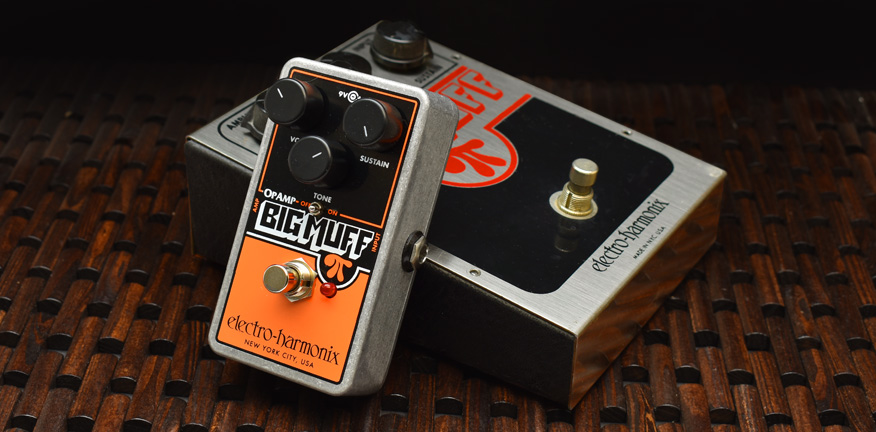
The 2017 Op-Amp reissue and an original V4 Op-Amp Big Muff
Your Pumpkin Pi. In December 2017 Electro-Harmonix continued with their line of Big Muff reissues (following the Green Russian) and released the Op-Amp Big Muff. It was marketed as "our faithful re-creation of the late ‘70s circuit. The circuitry of the Op-Amp Big Muff – sometimes also referred to as the IC or V4 Big Muff – differs from the traditional transistor-based Big Muff circuit in that it uses operational amplifiers (op-amps) to achieve its signature sustaining distortion sound." As I understand it, this reissue was based on an original schematic, not traced or measured from an actual vinatge V4 or V5 Big Muff.
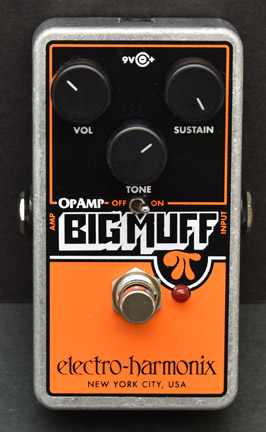
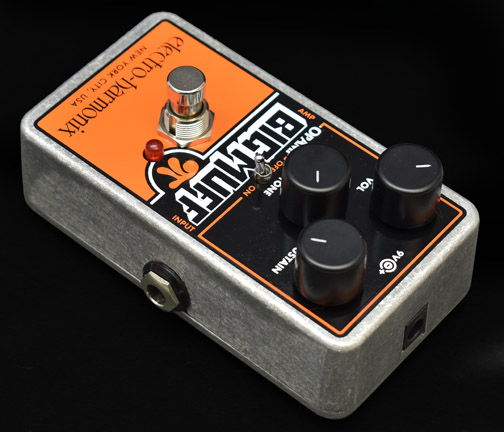
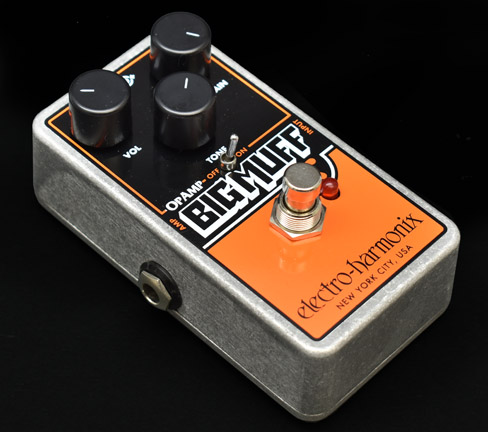
The Op-Amp Big Muff reissue from 2017
Billy Corgan of the Smashing Pumpkins did a promotional video for Reverb.com in December 2017, discussing the Smashing Pumpkins use of the Op-Amp Big Muff, and demoing the pedal. Corgan and James Iha recorded many songs with a V4 Big Muff that appear on their landmark albums Siamese Dream and Pisces Iscariot, all recorded in 1992-93. Billy did not know at the time about the op-amp circuit or what made that particular Big Muff sound different from others.
As a huge Pumpkins fan, I was chasing those same Siamese Dream tones other guitarists were. I had read that Billy used a Big Muff, but most people seemed to assume it was a transistor version. Having owned both versions of the op-amp Big Muffs, among many other versions in my collection, I believed that was likely what he used. In late 2009 Billy posted a photo of his actual Big Muff, showing the exact settings for Siamese Dream. That photo confirmed my suspicion was correct, as I identified it as a V4 Big Muff. The graphics match second edition V3 and V4 Big Muffs, but the tone and sustain pot sweep as Billy set them were only possible on a stock V4. I posted this revelation on a guitar forum at the time, not thinking anyone would care. Billy did not record with Big Muffs anymore, and the op-amp versions were looked down upon as inferior to the transistor versions at the time. They were cheap and easy to find if you wanted one, because no one wanted them. Unfortunately, once word spread, the resale prices skyrocketed and V4 and V5 Big Muffs soon became expensive and rare collectibles!
"Our original Op-Amp Big Muff was popularized by the brilliant Billy Corgan who first used it on the Smashing Pumpkins' epic 1993 album Siamese Dream. Now we've reissued that rare pedal." - Mike Matthews
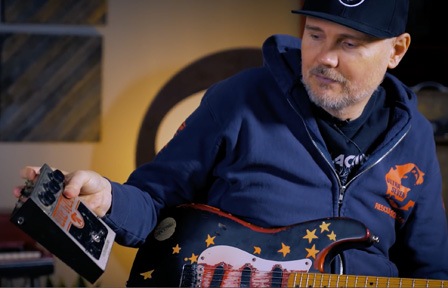
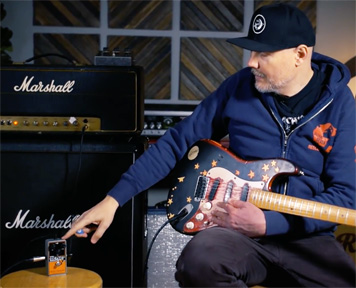

Billy Corgan of the Smashing Pumpkins with an original Op-Amp Big Muff and the reissue. (right) Billy with EHX founder Mike Matthews
CONTROLS - Standard volume, tone, and sustain cotrols as on the classic Big Muff. The reissue included a Tone Bypass switch, just like the V5 Big Muff. It completely bypassed the tone stage of the circuit, making for a brighter and harsher sound, but missing the trademark mid scoop Big Muffs were known for.
GRAPHICS AND ENCLOSURE - Housed in the standard EHX nano sized cast metal enclosure, 4 3/8" (L) x 1 3/8" (W) x 2 1/8"(H). The orange color in the graphics was in honor of the Smashing Pumpkins, who mastered the use of this pedal on their landmark album, Siamese Dream.
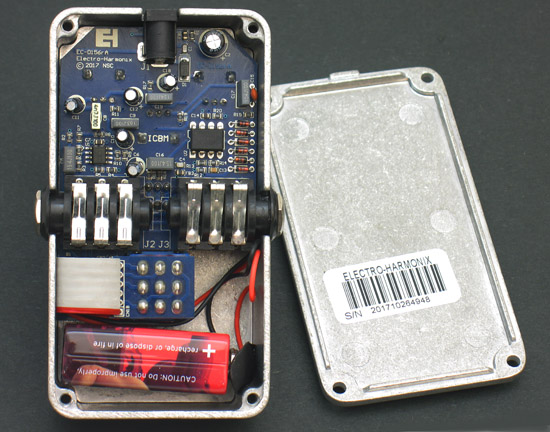
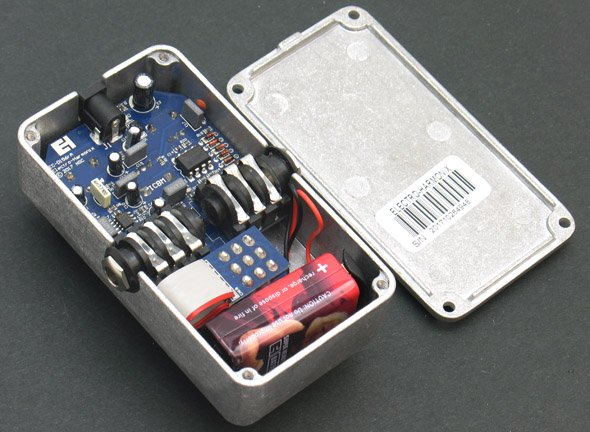
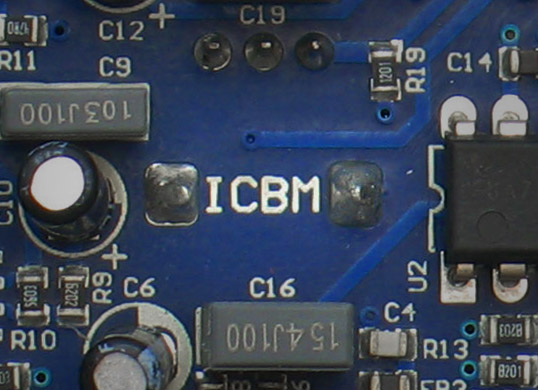
The Op-Amp Big Muff reissue circuit. ICBM is printed in the middle on the PCB, in honor of the Euthymia ICBM
CIRCUIT - The circuit uses normal through-hole style capacitors and diodes. All resistors are small surface-mount type. "ICBM" is printed on the circuit board, a reference the Euthymia ICBM, one of the first clones of the op-amp Big Muff. Long before the op-amp Big Muff was known to be the Siamese Dream Big Muff, the ICBM helped bring about a new interest for this somewhat underappreciated, and long discontinued, version of the circuit.
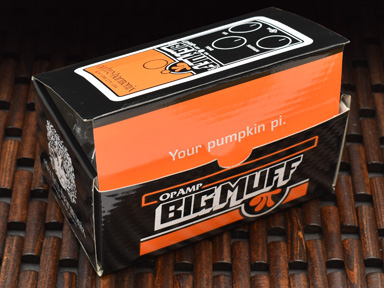
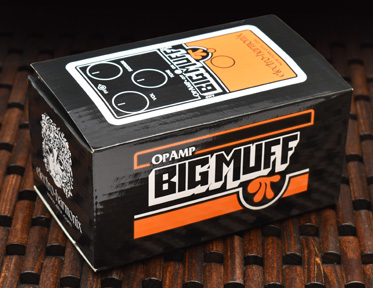
The Op-Amp Big Muff reissue packaging
PACKAGING - The standadrd nano-sized corrugated cardboard box with 3-color priting. "Your pumpkin pi" is printed on the inside box lid flap, a reference to the band Smashing Pumpkins.
CONTINUE - BACK TO THE HISTORY OF THE BIG MUFF PART 1 (Vintage USA)
HISTORY OF THE BIG MUFF PART 2 (Russian)
HISTORY OF THE BIG MUFF PART 3 (modern USA)
© Kit Rae. This page is not authorized, affiliated, or associated with Electro Harmonix in any way
Website and contents ©2007 and ©2010 Kit Rae. All rights reserved. Linking to this website is allowed, but copying the text content is strictly prohibited without prior authorization. No part of this work may be reproduced, stored in a retrieval system, or transmitted in any other form, or by any means, electronic, mechanical, photocopying, recording, computer networking, or otherwise without prior permission in writing from the copyright holder(s).
Kit’s Secret Guitar, Gear, and Music Page
Guitar stuff, gear stuff, soundclips, videos, Gilmour/Pink Floyd stuff, photos and other goodies.
Contact: nasnandos @ kitrae.net (remove spaces around @ to email)
Copyright Kit Rae.
VISIT MY SWORDS, KNIVES and FANTASY ART WEBSITE www.kitrae.net


